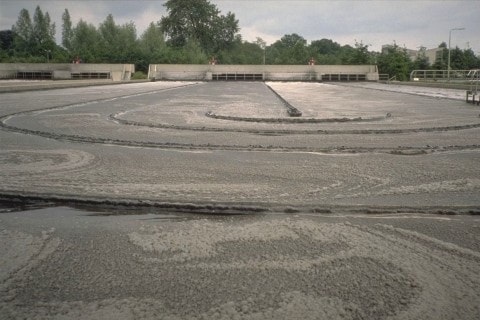Normal Biological Foam
As bacteria grow and divide, they produce extracellular materials including polysaccharides, proteins (enzymes), and even DNA/RNA. Also important for biofilm or floc adhesion, these materials trap air bubbles in a light color foam that is easily broken by waters spray if it even builds up more than 1 - 2" on the water surface. When the system is in log phase growth, you may notice both a lighter color and more foam than when the system is mature in decline phase growth.
Nocardia/Microthrix Parvicella (filaments)
Nocardia (often actually a Gordonia sp) is promoted by long chain fatty acids (FOG) and Microthrix is triggered often by low F/M, long chain fatty acids and lower temperatures. Both genera can exist in wastewater and not cause foaming, but under appropriate conditions, they start to produce hydrophobic extracellular materials. The hydrophobic biological polymers trap air and create the thick, stable, greasy foam. The best way to prevent foaming is to reduce grease and keep appropriate MCRT or F/M ratios in the system.
Surfactant Foams
Surfactants are used in many products not just cleaning agents. Firefighting foams, food product emulsion stabilizers, even many personal care products contain surfactant chemistries. Under normal concentrations, bacteria readily remove surfactants or they are diluted beyond their ability to reduce surface tension (creating foam). Periodically, you may see higher loadings hit the aeration basin. With surfactants the foam is usually stable and has a light color. While their presence is temporary and foam levels should drop, you can use commercial antifoam products to prevent excess foam during peak events.
Plant soaps, Starches, & Proteins
The above chemicals are natural polymers found in wastewater. Foaming occurrs when normal biological foam beomes stabilized by the natural polymers. In this case, antifoams and water sprays are often effective. We have also effectively used pretreatment with enzymes to pre-digest the polymers prior to the aeration basin - this can be very valuable in food processing wastewater treatment.


 RSS Feed
RSS Feed